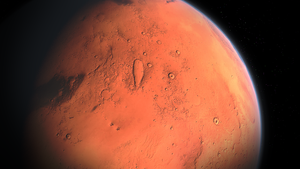After seven months travelling through space, NASA’s Mars Pathfinder Mission achieved a successful landing on the surface of the red planet late on 4 July. The six-wheeled robotic vehicle, named Sojourner, has been actively nosing up to selected boulders and carrying out extensive analyses of their composition.
The rocks have been given names designed to capture public interest: Barnacle Bill, Yogi, Scooby-Doo and Caspar.
The area chosen for the landing is in the Ares Vallis flood-plain. Twenty years ago, the Viking mission obtained images of Mars which suggested that the surface of the planet has been subjected to catastrophic floods, with surges of water eroding rocks, cutting channels and depositing sediment. The Pathfinder landing site was chosen to examine evidences of these water flows; it is thought that the rocks lying on the surface will exhibit a rich variety of compositions and textures, having been transported from a wide range of source areas. Already, reports are coming through to say that this flooding scenario is confirmed. Also, the rock Barnacle Bill has a chemical composition similar to that of the ‘martian meteorite’ suggested to contain fossilized micro-organisms — much publicized last year.
The realization that water once flowed on Mars has fanned the flames of excitement about the possibility of extra- terrestrial life. Project scientist Matthew Golombek is reported as saying: ‘The implications are enormous because liquid water is the key ingredient for life.’ Steve Stevenson, who leads the Sojourner part of the mission, said: ‘If life did arise on an Earth-like early Mars, fossil remains should be preserved in the surface rocks.’ This is the issue that is being picked up by media reports of these events. For example, the Daily Telegraph (6 July) started: ‘Sojourner was sent 120 million miles to hunt for signs of ancient life on the red planet.’
If fossil (or living) micro-organisms are discovered, supporters of the idea that life arises spontaneously will be overjoyed. They have been speculating over this for decades, and Mars is the most promising site — especially with the recent evidence of liquid water onthe planet. Christians have made two responses to the possibility: one is that the life has been transported from Earth, and the other is that God is perfectly entitled to create life on Mars if he so wills. However, other Christians are willing to predict that extra-terrestrial life will never be found, suggesting that the Bible relates the creation of living things to man: man has been given dominion over the rest of creation (and Mars is still beyond man’s sphere of dominion!).
Over the next decade, eight additional unmanned missions to Mars are planned, during which we can expect these issues to be brought regularly to our attention. When discussing the reports with others, we would do well to ask a few probing questions. For example, why is it that people are so desperate to find life outside Earth, when decades of strenuous effort by dedicated scientists to produce ‘life’ in the laboratory has only reinforced the thesis that life does not result from chemical reactions? Chemistry is completely unable to provide the biological information which is so abundant within every living thing. We might also enquire whether the confirmed catastrophic flooding of a large area of Mars provides any analogy with the Earth’s far more complex geologic history, and whether we should think again about the biblical history of a catastrophic flood.




















